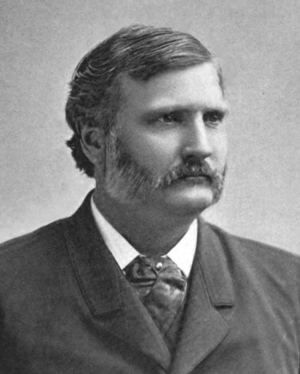Benjamin Butterworth facts for kids
Quick facts for kids
Benjamin Butterworth
|
|
|---|---|
 |
|
| Member of the U.S. House of Representatives from Ohio's 1st district |
|
| In office March 4, 1879 – March 3, 1883 |
|
| Preceded by | Milton Sayler |
| Succeeded by | John F. Follett |
| In office March 4, 1885 – March 3, 1891 |
|
| Preceded by | John F. Follett |
| Succeeded by | Bellamy Storer |
| Member of the Ohio Senate from the second district |
|
| In office January 5, 1874 – January 2, 1876 |
|
| Preceded by | Peter Murphy |
| Succeeded by | Peter M. Dechant |
| Personal details | |
| Born | October 22, 1837 Maineville, Ohio, U.S. |
| Died | January 16, 1898 (aged 60) Thomasville, Georgia, U.S. |
| Resting place | Rock Creek Cemetery Washington, D.C., U.S. |
| Political party | Republican |
| Alma mater | Ohio University |
| Profession | Politician, Lawyer |
Benjamin Butterworth (October 22, 1837 – January 16, 1898) was an important American lawyer and politician. He served as a U.S. Representative for the state of Ohio. He also held the important job of Commissioner of Patents.
Contents
Early Life and Education
Benjamin Butterworth was born on October 22, 1837. His birthplace was near Maineville, Ohio. As a young person, he went to local schools in Warren County, Ohio. He also attended an academy in Maineville. Later, he studied at Ohio University in Athens, Ohio.
A Family's Stand for Freedom
Benjamin's father was originally from Virginia. Even though he owned property, he strongly believed in freedom for everyone. Because of this, he chose to free his enslaved people. He then moved his family to Ohio. In Ohio, Benjamin's father worked with Levi Coffin. They helped people escape slavery through the Underground Railroad. This work continued until the end of the Civil War.
Starting a Career in Law and Politics
Benjamin Butterworth studied law. He became a lawyer in 1861. He started his law practice in Cincinnati, Ohio. In 1868, he was chosen to be an assistant United States district attorney. Later, he served as a member of the Ohio Senate. He was an Ohio Senator during 1874 and 1875.
Serving in the U.S. Congress
Benjamin Butterworth was elected to the U.S. Congress. He was a member of the Republican Party. He served two separate times as a U.S. Representative for Ohio. His first term was from March 4, 1879, to March 3, 1883. He tried to be re-elected in 1882 but did not win.
Important Roles and Contributions
Butterworth was a delegate to the Republican National Convention in 1880. He also served as a regent for the Smithsonian Institution. This meant he helped guide the famous museum and research center. In 1883, President Arthur appointed him a commissioner. This role was for the Northern Pacific Railroad. He also worked as a special lawyer for the government. He helped with election cases in South Carolina in 1883.
Return to Congress and Committee Work
Benjamin Butterworth was elected to Congress again. His second period in Congress was from March 4, 1885, to March 3, 1891. During this time, he led the United States House Committee on Patents. This committee dealt with new inventions and ideas. He decided not to run for re-election in 1890.
Later Career and Legacy
After his time in Congress, Butterworth returned to practicing law. He worked in Washington, D.C.. In 1896, he received another important appointment. He became the United States Commissioner of Patents. He held this position until he passed away.
World's Fair Success
In the early 1890s, Butterworth was appointed secretary. This was for the 1893 World's Fair. It was called the World's Columbian Exposition in Chicago. He was widely recognized for his important role. Many people believed he helped make the event a big success.
Ohio's "Big Four"
Benjamin Butterworth was considered one of "Ohio's big four" politicians. This group included other famous figures. They were William McKinley, Joseph Benson Foraker, and Charlie Foster.
Benjamin Butterworth passed away on January 16, 1898. He died from pneumonia in Thomasville, Georgia. He had traveled there for his health. He was buried in Rock Creek Cemetery in Washington, D.C.

